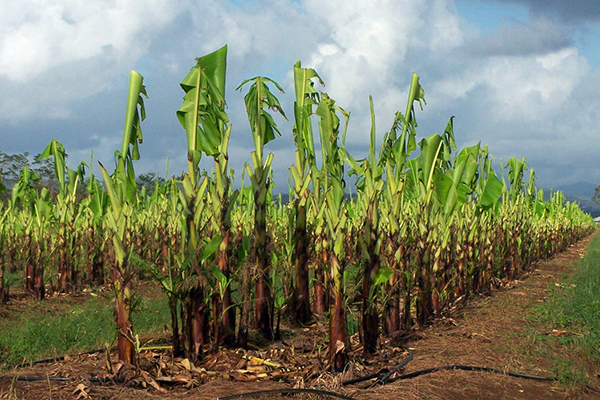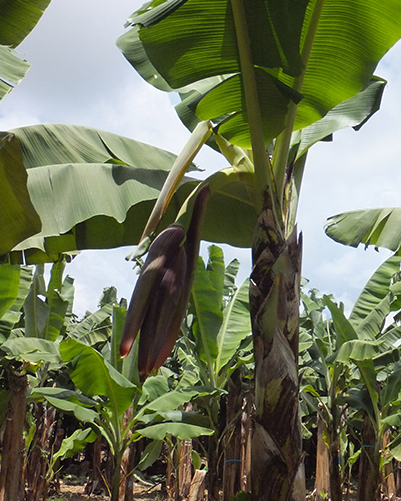Have a plan for your farm this cyclone season
This year’s monsoon activity is certainly living up to predicted forecasts because of the current La Nina weather pattern. Above average rainfall and an increase in cyclone activity has made for a wet and nervous start for 2021. While many banana growers are well accustomed to these conditions, it never hurts for growers to review their action plan in preparation of a cyclone hitting.
The following information runs through pre-and-post-cyclone management options and mainly focuses on the effects of canopy removal of unbunched plants before the cyclone hits, and the impact of staggering the return to cropping on the subsequent fruit supply. The management options were investigated as part of an industry project in 2011/12 and remain current.

What to consider when preparing for tropical cyclones
Bananas are very prone to wind damage and losses can be severe, even with low-category cyclones or severe thunderstorms. The likelihood of banana crop damage relates directly to wind strength, the wind resistance presented by a plant and the presence or absence of a bunch.
Pre-and-post-cyclone management options were investigated in 2011/12 in an industry project, which looked at the effects of canopy removal of unbunched plants before the cyclone hits, and the impact of staggering the return to cropping on the subsequent fruit supply.
Step 1 — looking at your blocks
The first step is to develop a clear idea of the stage of development of the blocks on the farm. How many blocks are plant crops, early ratoons or nurse-suckered, all of which will be more uniform than older ratoons. Of the more uniform blocks, identify those which are heavily bunched, those where the bulk of plants are close to bunching (within 4-6 weeks) and those which are about 2-3 months from bunching.
The uniform unbunched blocks offer the best opportunity to efficiently apply techniques like canopy removal rather than older ratoon blocks.
Step 2 — deciding whether to remove the canopy
The next step is to decide which blocks are most appropriate for treatments like canopy removal, which depends not only on the plant development stage but also the likely wind strength.
With any cyclone the bunched and large unbunched banana plants are most at risk, so strategies to reduce the wind resistance of these plants can help reduce the damage.
Canopy removal of unbunched plants prior to the cyclone helps to reduce the incidence of plants rolling out and can provide early bunch production. However, removing the canopy has major impacts on yield and fruit length, with 35- 50% reductions in bunch weight and 20-35% reductions in proportion of fruit in the extra large (220-260mm) fruit category (Table 1). Reductions in fruit length were most pronounced in the plants closest to bunching (4-5 weeks) while the biggest reductions in bunch weight occurred for plants that were 13-14 weeks from bunching.
Therefore a fair degree of certainty of damage is needed before embarking on canopy removal on a large scale. For a low-category or physically small cyclone, often the decision to remove the canopy is best left to the latest practical time possible.
Step 3 – how to cut if removing canopy
The way the canopy is removed is also important. ‘Full deleafing’ where the stem was not cut, resulted in a stronger stem that was better able to support a subsequent bunch compared to plants that had been cut through well below the ‘throat’ of the plant. See figures 2 and 3.


Results — canopy removal by 'full deleafing' of unbunched plants
Table 1 Bunch and plant characteristics for the canopy removal treatments

More information...
For important information on minimising the spread of Panama disease during and after a cyclone event refer to the ABGC fact sheet.
Contact our team:
The Better Bananas team
Department of Agriculture and Fisheries
South Johnstone
07 4220 4177 or email betterbananas@daf.qld.gov.au
Horticulture Innovation Australia (Hort Innovation) and the Queensland Government make no representations and expressly disclaim all warranties (to the extent permitted by law) about the accuracy, completeness, or currency of information in this factsheet. Reliance on any information provided by Hort Innovation and the Queensland Government is entirely at your own risk. Hort Innovation and the Queensland Government are not responsible for, and will not be liable for, any loss, damage, claim, expense, cost (including legal costs) or other liability arising in any way (including from Hort Innovation and the Queensland Government or any other person’s negligence or otherwise) from your use or non-use of this factsheet or from reliance on information contained in the material or that Hort Innovation and the Queensland Government provides to you by any other means.




